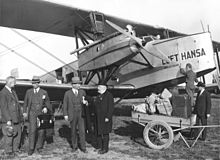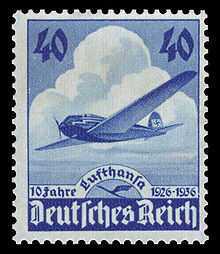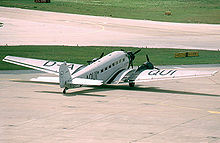- Deutsche Luft Hansa
-
This article is about the airline in operation between 1926 and 1945. For other airlines of that name, see Lufthansa (disambiguation).
Deutsche Luft Hansa 
IATA ICAO Callsign Founded 1926 Ceased operations 1945 Hubs Berlin Tempelhof Airport Destinations Headquarters Berlin, Germany Deutsche Luft Hansa A.G. (from 1933 styled as Deutsche Lufthansa, often shortened to Luft Hansa respectively Lufthansa and abbreviated DLH) was a German airline, serving as flag carrier of the country during the later years of the Weimar Republic and throughout the Third Reich.
Contents
History
1920s
 A Deutsche Luft Hansa Albatros L 73, named Brandenburg, at Stettin Airport (1927). In the front ground Yngve Larsson, the then mayor of Stockholm.
A Deutsche Luft Hansa Albatros L 73, named Brandenburg, at Stettin Airport (1927). In the front ground Yngve Larsson, the then mayor of Stockholm.
 A preserved Junkers F.13, a type which was operated by Luft Hansa.
A preserved Junkers F.13, a type which was operated by Luft Hansa.
Deutsche Luft Hansa was founded on 6 January 1926 in Berlin. The name of the company was a composite of "Deutsche Luft" ("German Air" in German), and "Hansa" (after the Hanseatic League, a powerful medieval trading group). The airline was created by a merger between Deutscher Aero Lloyd (an airline formed in 1923 as a co-operation between the shipping companies Norddeutscher Lloyd and Hamburg America Line) and Junkers Luftverkehr, the in-house airline of Junkers.[1] This action was taken due to an initiative of the German government which hoped to reduce the amount of financial support it provided to the two partly state-owned airlines, which were both plagued by heavy debts at that time.
The foundation of the airline coincided with the lifting of the restrictions of commercial air operations that had been imposed upon Germany by the Treaty of Versailles. This allowed the route network to be quickly expanded to cover the major European cities. The initial fleet consisted of 162 aircraft, nearly all of them outdated World War I types, and the company had 1,527 staff. The most important airfield for DLH was Berlin Tempelhof. From there a Fokker F.II took off on 6 April 1926 for the first schededuled flight to Zürich via Halle, Erfurt and Stuttgart. In the same year, Deutsche Luft Hansa acquired a stake in Deruluft, a joint German-Soviet airline, and launched non-stop flights from Berlin to Moscow, which was then regarded as an exceptionally long distance. Shortly after that flights to Paris were commenced. Deutsche Luft Hansa was one of the first airlines to operate night flights, the first of which connected Berlin with Königsberg using Junkers G 24 aircraft. This route proved so successful that the night train connection was discontinued some years later. During its first year, the airline operated more than 6 million flight kilometres, transporting a total of 56,268 passengers and 560 tons of freight and post.
Over the following years, the domestic network grew to cover all the important cities and towns of Germany. More international routes were added through co-operation agreements. With the newly founded Iberia in Spain its the longest scheduled route was 2,100 kilometres from Berlin to Madrid (though with several stopovers). The establishment of Syndicato Condor in Brazil served the airline's interests in South America where there were important German minorities at that time. The first East-West crossing of the Atlantic Ocean (from Baldonnel Aerodrome in Ireland to Greenly Island, Canada) was made by the Luft Hansa pilots Hermann Köhl and Ehrenfried Günther Freiherr von Hünefeld and the Irish pilot James Fitzmaurice using the Junkers W 33 aircraft Bremen in April 1928. The airline launched scheduled multi-leg flights to Tokyo. A Heinkel HE 12 aircraft was launched (by catapult) off the NDL liner Bremen during her maiden voyage crossing the Atlantic in 1929, shortening the mail delivery time between Europe and North America.
1930s
 A scale model of a Deutsche Lufthansa Focke-Wulf Fw 200.
A scale model of a Deutsche Lufthansa Focke-Wulf Fw 200.
Even though the early years of the decade saw a difficult financial situation due to the Great Depression, Deutsche Luft Hansa further expanded its international route network in South America, and launched scheduled flights from Germany to the Middle East. Politically, the company leaders were linked to the rising Nazi Party; an aircraft was made available to Adolf Hitler for his campaign for the 1932 presidential election free of any charge. Erhard Milch, who had served as head of the airline since 1926, became a high-ranking official at the Aviation Ministry when Hitler came to power in 1933.
A key interest of Deutsche Luft Hansa at that time was the reduction of mail delivery times. In 1930, the Eurasia Corporation was established as a joint-venture with the Chinese transport ministry, granting Luft Hansa a monopoly position for mail transport between Germany and China, as well as access to the Chinese market. To this end, the Shanghai-Nanjing-Beijing route was launched in the following year using Junkers W 34 specially deployed there. A record was set in 1930 when the mail route from Vienna to Istanbul (with stopovers in Budapest, Belgrad and Sofia) was completed in only 24 hours. By comparison, the first transatlantic passenger flight by the airline (from Warnemünde to New York City using a Dornier Wal flying boat) took roughly one week.
After several years of testing, the first scheduled postal route between Europe and South America was inaugurated in 1934. For this purpose, catapult-launched Wal flying boats were used.[2] These were replaced by the Dornier Do 18 in 1936 making operations in non-visual conditions possible. The European network saw the introduction of the Junkers G.38 (at that time the largest passenger aircraft in the world) on the Berlin-London route via Amsterdam, as well as the Junkers Ju 52/3m and Heinkel He 70, which allowed for faster air travel. This was promoted by so called "Blitz Services" (German: Blitzstrecken) between Berlin, Hamburg, Cologne and Frankfurt. In 1935, the first aircraft not manufactured in Germany were introduced into the Luft Hansa fleet: two Boeing 247s and one Douglas DC-2.
The grip on the domestic South American markets was further tightened in 1937, when the Sociedad Ecuatoriana de Transportes Aereos[3] and Lufthansa Perú were founded as Luft Hansa co-operations in Ecuador and Peru respectively, operating Junkers W 34 aircraft. The Middle Eastern network was expanded with the launch of the Berlin-Baghdad-Tehran route in the same year. In 1938 the Focke-Wulf Fw 200 long range aircraft was introduced making it possible to fly non-stop between Berlin and New York and from Berlin to Tokyo with only one intermediate stopover. This last year prior to the outbreak of World War II turned out to be the most successful one in the history of the airline, with 19.3 million flight kilometres on the scheduled European routes and a total of 254,713 passengers and 5,288 tons of mail transported.
On 1 April 1939, Deutsche Luft Hansa launched scheduled transatlantic flights between Port Natal, South Africa and Santiago de Chile using Fw 200 aircraft, a route which had previously been operated by Syndicato Condor. With Bangkok, Hanoi and Taipeh, further Asian destinations were added to the route network.
During the 1930s, Luft Hansa aircraft had also been deployed on a number of experimental and survey missions, most notably for developing the best airborne crossing of the South Atlantic, and during the Third German Antarctica Expedition in 1938-39, when two Dornier Wal aircraft performed a photographic survey of 350,000 square kilometres, an area which became known as New Swabia.
During World War II
With the outbreak of the war on 1 September 1939 all civilian flight operation of Luft Hansa came to an end, and the aircraft fleet came under command of the Luftwaffe, along with most staff as well as maintenance and production facilities. There were still scheduled passenger flights within Germany and to occupied or neutral countries, but bookings were restricted and served the demands of the warfare. During the later years of the war, most passenger aircraft were converted to military freighters.
The Luft Hansa co-operations in foreign countries were gradually dismantled: Deruluft ceased to exist in March 1940, and by November of that year, the Eurasia Corporation had to be shut down following an intervention by the Chinese government. Syndicato Condor was nationalized and renamed Cruzeiro do Sul in 1943, in an attempt to erase its German roots.
The last scheduled flight of Deutsche Luft Hansa from Berlin to Munich took place on 21 April 1945, but the aircraft crashed shortly before the planned arrival. Another (non-scheduled) flight was performed the next day, from Berlin to Warnemünde, which marked the end of flight operations. Following the surrender of Germany and the ensuing Allied occupation of Germany, all aircraft in the country were seized and Deutsche Luft Hansa was dissolved. The remaining assets were liquidated on 1 January 1951.
Legacy
Lufthansa, today's German flag carrier, acquired the name and logo of the 1926-1945 airline upon its foundation in 1953 and considers the former airline to be part of its history, even though there is no legal link between the two companies. Between 1955 and 1963, the newly-founded East German national airline operated under the same name but, having lost a lawsuit with the West German company, it was renamed Interflug.
Route network
European passenger flights
From 1926 until the outbreak of World War II in 1939, Deutsche Luft Hansa built up an extensive network centred on its base at Berlin Tempelhof Airport covering many German cities and towns , as well as the major European cities. There were early interline agreements which granted Luft Hansa passengers access to the flight network of leading European airlines of that time and vice versa. The agreements were with air lines including Aerotransport, Ad Astra Aero, Adria Aerolloyd, Aero Oy, Air Union, Balair, CIDNA, CSA, DDL, Imperial Airways, KLM, Lignes Aeriennes Latécoère, LOT, ÖLAG, Malert, SABENA, SANA, SGTA, and Ukrvozdukhput, as well as Syndicato Condor from Brazil and SCADTA from Colombia.
During that period, the following European destinations saw scheduled passenger flights:[4][5]
During World War II
Due to the war and the de-facto end of commercial air transport in Germany, Luft Hansa operated scheduled passenger flights only on some trunk domestic trunk routes and international services on a limited number of routes to occupied or Axis-affiliated countries. These routes deteriorated during the war as Germany came closer to defeat.
As of 1940/41, the following destinations were served. At that time, interline agreements were in force with Iberia, Aeroflot, Malert, LARES (Romania), Aero Oy (Finland, DDL (occupied Denmark), ABA (Sweden), and CSA (occupied Czechoslovakia).
- Bulgaria
- Denmark
- German Reich
- Berlin - Tempelhof Airport (hub)
- Breslau - Gandau Airport
- Danzig - Langfuhr Airport
- Königsberg - Devau Airport
- Munich - Riem Airport
- Prague - Rusin Airport
- Stuttgart - Echterdingen Airport
- Vienna - Aspern Airport
- Greece
- Hungary
- Budapest - Budaörs Airport
- Italy
- Norway
- Romania
- Arad - Arad Airport
- Bukarest - Băneasa Airport
- Portugal
- Lisbon - Granja do Marques Airport
- Soviet Union
- Belostok - Belostok Airport
- Minsk - Minsk Airport
- Moscow - Khodynka Aerodrome
- Spain
- Barcelona - Muntadas Airport
- Madrid - Barajas Airport
- Sweden
- Switzerland
- Turkey
- Yugoslavia
Additionally, there were scheduled sea plane flights along the Norwegian coast (from Trondheim to Kirkenes), which was then part of the Atlantic Wall.
Fleet
 The Deutsche Luft Hansa Ju 52 Otto Falke with running engines at Belgrade-Dojno polje Airport, Kingdom of Yugoslavia. (1941)
The Deutsche Luft Hansa Ju 52 Otto Falke with running engines at Belgrade-Dojno polje Airport, Kingdom of Yugoslavia. (1941)
Over the years of its existence, Deutsche Luft Hansa operated the following aircraft types:
-
This list is incomplete; you can help by expanding it.
Deutsche Luft Hansa fleet history[citation needed] Aircraft Introduced Retired Notes Arado V I 1929 1929 1 only, cargo, lost in crash BFW M.20 1929 1943 14 Blohm & Voss Ha 139 1938 1940 cargo floatplane Blohm & Voss BV 142 1939 1940 cargo Boeing 247 1935 Dornier Do 18 1937 1939 cargo flying boat Dornier Do R 1928 1932 flying boat Dornier Komet III 1926 Dornier Wal 1926 1940 cargo flying boat Douglas DC-2 1935 Douglas DC-3 1940 1944 Focke-Wulf A 32 1934 from NOBA Focke-Wulf A 33 1937 1 only Focke-Wulf A 38 Focke-Wulf Fw 200 1938 1945 Fokker-Grulich F.II
Fokker-Grulich F.III1926 1935 Heinkel He 12 1929 cargo Heinkel He 58 1930 cargo Heinkel He 70 1934 1938 cargo Heinkel He 116 1938 cargo Junkers F.13 1926 1938 Junkers G 24 1926 1938 Junkers G 31 1928 1936 8 aircraft Junkers G.38 1931 2 only, one written off after crash in 1936. Junkers Ju 46 1933 1939 cargo Junkers Ju 52 1932 1945 Junkers Ju 60 1934 1940 Junkers Ju 90 1938 1940 Junkers W33
Junkers W34
cargo1928 Rohrbach Ro VIII 1931 Rumpler C1/5A2 1926 Udet U-11 1926 1929 1 only Accidents and incidents
- On 6 November 1929, a Deutsche Luft Hansa Junkers G 31 (registration D-903, named Oberschlesien) en route from Croydon to Schipol crashed in thick fog at Godstone, Surrey, United Kingdom, resulting in the deaths of seven of the eight people on board.[6]
- On 29 October 1932, a Deutsche Luft Hansa Junkers W33 (registered D-2017, named Marmara) was on a freight flight from Croydon Airport to Cologne when it crashed off the Kent coast.[7]
- During the war, on 27 September 1944 at 20:30 local time, a Luft Hansa Focke-Wulf Fw 200 (registered D-AMHL) was shot down by a Bristol Beaufighter near Dijon. The aircraft had been on a scheduled passenger flight from Stuttgart to Barcelona with five passengers and four crew members on board, all of which were killed.[8]
- On 16 October 1944, a Luft Hansa Junkers Ju 52 (registered D-ADQU) crashed into a mountain in Telemark county, Norway in poor visibility conditions, killing the 15 people on board.[9]
- 29 November 1944 at 10:25 local time, a Deutsche Luft Hansa Focke-Wulf Fw 200 (registered D-ARHW) was accidentally shot down by a German "patrol boat" off the Swedish coast during a flight from Berlin to Stockholm, killing the six passengers and four crew members on board.[10]
- On 21 April 1945, during the Battle of Berlin, a Deutsche Luft Hansa Fw 200 (registered D-ASHH, Hessen) escaped from Berlin for a flight to Munich, but crashed near Obertraubling in Bavaria, killing the sixteen passengers and five crew members. The loss was the worst accident involving an aircraft of that type and also for the airline.[11][12]
References
- ^ Lufthansa Chronicle
- ^ "First Tranatlantic air line", Popular Science, February 1933, http://books.google.com/books?id=pigDAAAAMBAJ&pg=PA13&dq=Popular+Science+1931+plane&hl=en&ei=q78LTaeBEcyTnQf_5cHUDQ&sa=X&oi=book_result&ct=result&resnum=6&ved=0CDkQ6AEwBTgK#v=onepage&q=Popular%20Science%201931%20plane&f=true
- ^ "Sedta Cuts Rates". Time Magazine. January 27, 1941. http://www.time.com/time/magazine/article/0,9171,801249,00.html. Retrieved 2007-09-14.
- ^ Deutsche Luft hansa 1927 timetable at timetableimages.com
- ^ Deutsche Luft Hansa 1932 timetable at timetableimages.com
- ^ "Luft Hansa disaster", Flight, 15 November 1929, http://www.flightglobal.com/pdfarchive/view/1929/1929-1%20-%201633.html
- ^ "Airport News - Croydon". Flight (3 November 1932): p1027. http://www.flightglobal.com/pdfarchive/view/1932/1932%20-%201107.html.
- ^ ASN Aircraft accident Focke-Wulf Fw 200 D-AMHL Dijon Aviation Safety Network
- ^ 1944 crash at the Aviation Safety Network
- ^ ASN Aircraft accident Focke-Wulf Fw 200 D-ARHW Målkläppen at the Aviation Safety Network
- ^ ASN Aircraft accident Focke-Wulf Fw 200KB-1 D-ASHH Piesenkofen Aviation Safety Network
- ^ German article on the 1945 aircrash
Categories:- Airlines established in 1926
- Airlines disestablished in 1945
- Defunct airlines of Germany
Wikimedia Foundation. 2010.


